
© Erik Tomasson. (Click image for larger version)
San Francisco Ballet
Program 6, Shostakovich Trilogy: Symphony #9, Chamber Symphony, Piano Concerto #1
San Francisco, War Memorial Opera House
08 April 2015
www.sfballet.org
It’s a disconcerting feeling when you don’t respond to a piece that nearly everyone else agrees is revelatory. That’s the situation I find myself in with Alexei Ratmansky’s Shostakovich Trilogy. Critical and audience receptions to its world premiere, in May 2013 at American Ballet Theatre, then again over its April 2014 premiere at San Francisco Ballet (the work was created through a co-production between the two companies) were ecstatic, describing Shostakovich Trilogy as powerful, moving, groundbreaking. Maybe it’s all of those things and I just have a blind spot; both times I’ve seen it, at that SFB premiere and at the Wednesday, April 8, opening of this season’s reprise, I walked away wondering what I was missing. It turns out that my appreciation for it is just a bit topsy-turvy.
A tripartite, full-evening epic of contemporary ballet, Shostakovich Trilogy is Ratmansky’s hymn to his native Russia and to Dmitry Shostakovich, the Soviet composer whose tribulations encapsulate everything that was wrong about that era: public denunciations and near-suicide, profound loss during the Great Terror, compulsory membership in the Communist Party he loathed. At 46, Ratmansky enjoys the artistic freedom Shostokovich never had, yet is old enough to remember life behind the Iron Curtain. Perhaps that helps explain the composer’s hold on Ratmansky, who to date has set a dozen works to the composer’s music.

© Erik Tomasson. (Click image for larger version)
Ratmansky structured the trilogy around the 1945 Symphony #9, nominated for a Stalin Prize after its premiere, then denounced as formalist, the1960 Chamber Symphony (actually Barshai’s string arrangement of String Quartet #8), written during a deep depression and imbued with Shostakovich’s DSCH motif; and the 1933 Piano Concerto #1, a triumphant fanfare composed during one of the brief periods when Shostakovich enjoyed the Soviet regime’s favor.
In Symphony #9 (the sections are named after their music, and Symphony #9 is also a stand-alone piece that premiered at ABT in October 2012), Vanessa Zahorian and James Sofranko gleefully led their sporty fellow villagers in folksy dances, while Sarah Van Patten and Luke Ingham’s adagio suggested the dread that underlay the smug Soviet façade; Hansuke Yamamoto wandered among them with pliant jumps and turns.
As the tragic hero of Chamber Symphony, Davit Karapetyan adored and then agonized over an endearing Dores André, a moribund Mathilde Froustey and a wavering Van Patten, portraying the women Shostakovich loved and lost. Frances Chung with Joan Boada and Sofiane Sylve with Tiit Helimets infused the allegro steps of Piano Concerto #1 with a dose of welcome electricity; the women’s spare red swimsuits and the men’s graphite unitards highlighted a muscularity that would have made the Ministry of Health glow with pride. The triumphant dancing paid reverence to George Tsypin’s backdrop of neon-red stars, hammers, sickles and airplanes.

© Erik Tomasson. (Click image for larger version)
For many viewers, these portrayals compel empathy, sympathy and compassion for what Shostakovich lived through. Yet to my eye, the principal choreography reads as too traditional for its avant-garde subject, too comfortable to set the audience’s teeth on edge. I missed the thrilling expressionism of The Bolt, Ratmansky’s 2005 re-creation of a full-length ballet composed by Shostakovich in 1930, choreographed by Fyodor Lopukhov (his choreography is long lost) and banned after its first and only performance in 1931 for insufficient Soviet-ness. Not that it’s appropriate to ask an artist to repeat himself; my point is rather that Ratmansky conjures wonders at the extreme ends of the spectrum, whether the social realism of The Bolt or the delicate Baroque restoration of his new version of The Sleeping Beauty, and here the principal choreography seems needlessly safe.
My eye drifted from the principals to the corps, and that’s where I found the emotion of Shostakovich Trilogy. The eight women and eight men carry the non-narrative story via choreographic double entendres. In Symphony #9, they echo the triumphal strains of the music with arm gestures that look deceptively like classical port de bras, yet evoke domestic chores, agricultural work and the postured bluffing of propaganda art.
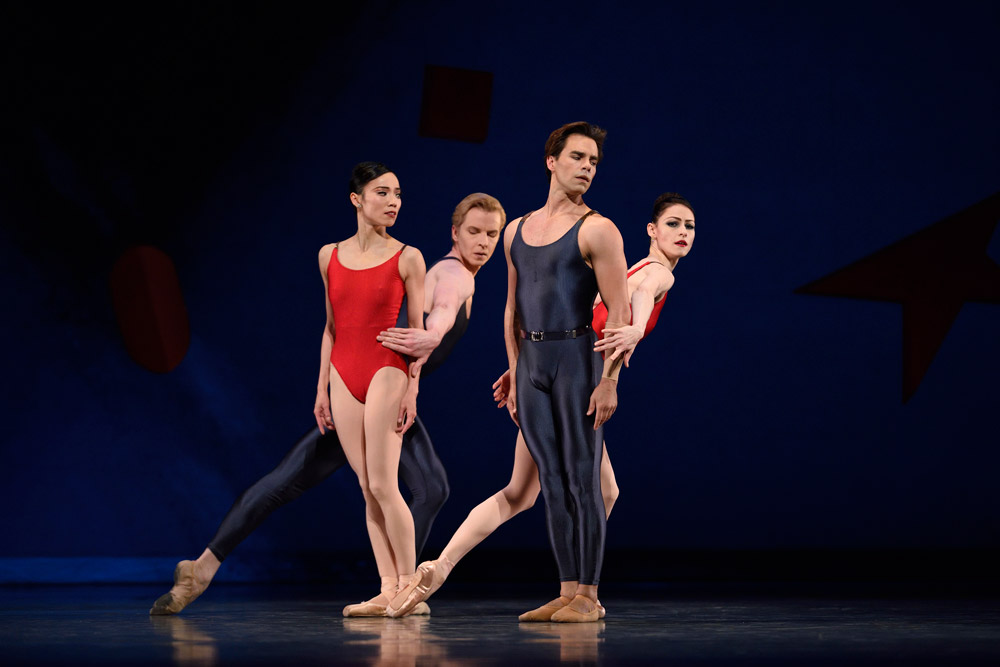
© Erik Tomasson. (Click image for larger version)
The black-clad men of Chamber Symphony serve as a Greek chorus, or perhaps a Stalinist one, blocking Karapetyan from reaching Froustey. Dressed in the bi-color unitards of Piano Concerto #1, the corps transitions from grands jetes, arabesques and liquid torsos to towering lifts that evoke a flag-waving Soviet victory parade. Ratmansky layers their steps with social commentary, as Shostakovich often did in his music, and the SFB corps danced them with enthusiasm, power and beautiful articulation.
Loath to speak to the press, Ratmansky has not divulged what the parts and pieces Shostakovich Trilogy mean to him, and it would be rude to draw inferences. Nonetheless, I can’t help but read in this work a meta-drama of Ratmansky sorting out his connection to Shostakovich and their shared history – making Shostakovich Trilogy a tantalizing glimpse into the heart of a gifted artist.











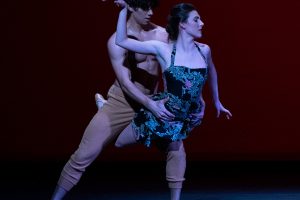
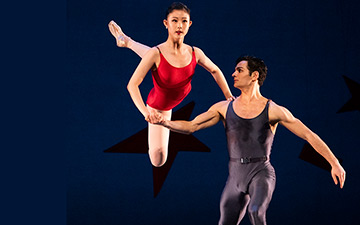

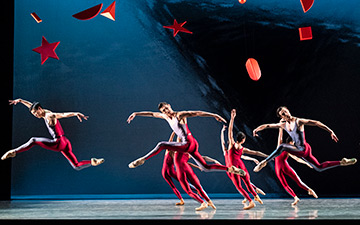
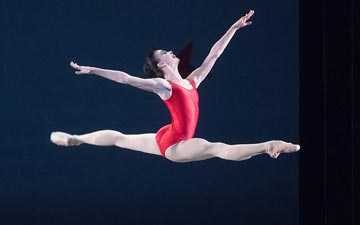

You must be logged in to post a comment.